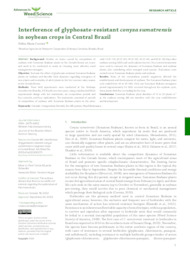Interference of glyphosate-resistant conyza sumatrensis in soybean crops in Central Brazil.
Interference of glyphosate-resistant conyza sumatrensis in soybean crops in Central Brazil.
Author(s): CORREIA, N. M.
Summary: Abstract: Background: Studies on losses caused by competition of soybean with Sumatran fleabane plants in the Cerrado biome are scarce and need to be conducted to assist in choosing more effective weed management strategies. Objective: Evaluate the effect of glyphosate-resistant Sumatran fleabane plants on soybean and describe their dynamics regarding emergence of new plants and mortality of adult plants in the hot summer rainy season in the Cerrado biome. Methods: Three field experiments were conducted at the Embrapa Cerrados site (Brasília, DF, Brazil) over two years, using a randomized block experimental design with ten treatments, six competition periods and four controls, and four replications. The treatments consisted of periods of competition of soybean with Sumatran fleabane plants in the plots: until 10 (0–10), 20 (0–20), 30 (0–30), 45 (0–45), and 60 (0–60) days after soybean sowing (DAS) and until soybean harvest. Four control treatments were used to evaluate the dynamics of Sumatran fleabane and soybean plants, also considering other emerged weed species. Evaluations were carried out on Sumatran fleabane plants and soybean. Results: None of the competition periods negatively affected the establishment and development of soybean. The Sumatran fleabane plant cycle ended from 45 to 60 DAS. Only one Sumatran fleabane emergence period (approximately 24 DAS) occurred throughout the soybean cycle, these plants died due to shading by the crop. Conclusions: Sumatran fleabane plant densities of 13 to 23 plants m-2 at the soybean sowing did not interfere with the crop establishment and development.
Publication year: 2023
Types of publication: Journal article
Unit: Embrapa Cerrados
Keywords: Cerrado, Erva Daninha, Plantio Direto, Resistência, Soja, Soybeans
Observation
Some of Embrapa's publications are published as ePub files. To read them, use or download one of the following free software options to your computer or mobile device. Android: Google Play Books; IOS: iBooks; Windows and Linux: Calibre.
Access other publications
Access the Agricultural Research Database (BDPA) to consult Embrapa's full library collection and records.
Visit Embrapa Bookstore to purchase books and other publications sold by Embrapa.

